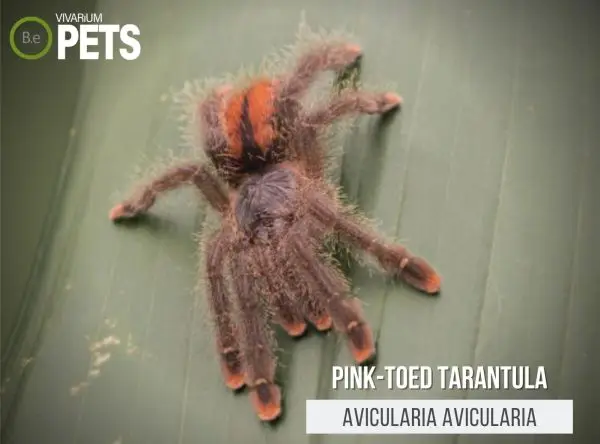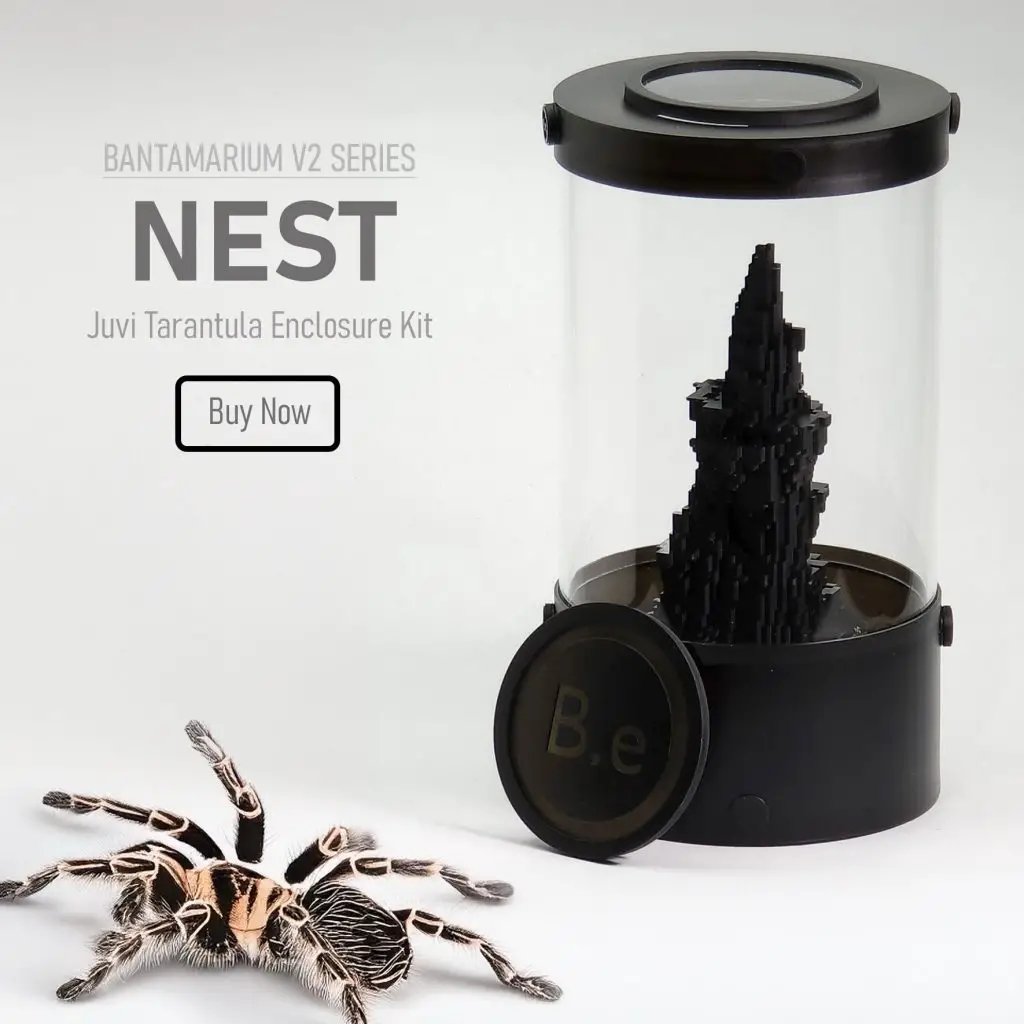The Pink-Toed Tarantula is an alluring spider with qualities that even the most skittish would find hard to resist!
This guide will provide the information and care instructions you need to feel confident in providing a great habitat for your pet tarantula.
From understanding the perfect environment to diet and feeding habits, you’ll find everything you need to know to make Avicularia avicularia right at home!
Table Of Contents:
ToggleWhat Are Pink-Toed Tarantulas?
Pink-toed tarantulas, scientifically known as Avicularia avicularia, is a species of arachnid that belongs to the family Theraphosidae.
These spiders are found in wet subtropical areas from Mexico to Bolivia and can live for many years.
Their common name comes from the light pink coloring of their feet.
Create the perfect home for your arachnid with our Customizable Spider Enclosure Kits, designed to meet all their habitat needs.
What Do Pink-Toed Tarantulas Look Like?
Pink-toed tarantulas have a distinct look making them quite easy to identify.
They measure up to 6 inches in length and have a unique pattern on their abdomens.
The body is generally black with a bright pink or red coloration around the feet.
Their legs are thick and covered with small spikes and hairs. The unique pattern of their abdomen helps keep predators away.
Furthermore, their body is covered in short hairs and bristles which serves to protect them from dehydration.
They have eight eyes which all are located on the front of their head.
All of these features come together to create the distinct look of the Avicularia avicularia.
Benefits Of Using Pink-Toed Tarantulas
The Pink-Toed Tarantula makes for an excellent pet for vivariums due to its size and active demeanor.
These tarantulas tend to move around more during the day and are not skittish like other spider species, and they don’t require as much space as larger breeds.
Additionally, their unique pink legs and brown fuzzy body add a vibrant and interesting element to any enclosure.
They are active yet gentle and entertaining to observe.
Plus, with the right setup and care, they are relatively straightforward to care for, making them perfect for beginner tarantula enthusiasts.

Pink-Toed Tarantula Facts
Avicularia avicularia are unique and fascinating spiders that typically grow up to a few inches long.
They are native to South and Central America and can live for many years with proper care.
These tarantulas have a gentle temperament and feed on a variety of insects. Breeding can be successful with the right conditions and setup.
Habitat
The Pink-Toed Tarantula originate from the tropical regions of South America, predominantly from tropical forests located in Brazil, Venezuela, Peru, French Guiana, and Guyana.
It’s usually found inhabiting moist, ground-level areas.
Avicularia avicularia have adapted to many different climates, yet prefer warmer, wetter climates with temperatures ranging between 65 and 85 degrees Fahrenheit.
The natural environment of the spider varies slightly between geographical locations.
Those found inhabiting forests will typically have their hides surrounded by logs, tree bark, and other natural debris.
Meanwhile, those living in more urban settings will usually be found in jungle gardens set up in backyards.
As the Pink-Toed Tarantula is a ground dweller, they will also be found hiding in large leafy vegetation or shallow burrows.
Replicate their natural habitat perfectly with our bioactive species-specific soil mixes, designed to provide the ideal moisture and organic content for your spiders.
Diet
The diet of Avicularia avicularia in their natural habitat consists primarily of insects, small invertebrates, and other spiders.
They will also eat small mammals such as lizards and mice if they are available.
The tarantula is an ambush predator, meaning it can wait for hours for the right opportunity before attacking its prey.
They will typically feed every five to seven days, but it can be longer in a more natural environment.
During the night, this species will actively search for food; however, during the day, they will generally remain in their burrows.
Temperament
A. avicularia is known to be an incredibly docile spider that is typically not aggressive toward humans or other animals.
They are generally shy and reclusive creatures, preferring to stay in the safety of their habitat.
Despite this, they can easily learn to accept being handled when they get comfortable with their environment and understand that they are not in any danger.
That being said, they would much rather stay in their environment by themselves unless they willingly choose to come out.
When it comes to sharing enclosures, Pink-Toed Tarantulas typically do not get along with one another, especially if there is not enough room for each spider.
Lifespan
The average lifespan of Avicularia avicularia is 2 to 3 years, with females living as long as 6 to 9 years.
Their life cycle is relatively simple, beginning as an egg and then hatching into a spiderling, which is very small and fragile but grows quickly.
The spiderling goes through several molts before reaching maturity at about 18 months.
As an adult, the tarantula is sexually mature and can begin reproducing, typically laying up to 100 eggs in a single clutch.
Breeding
When it comes to reproduction, the mating process of Avicularia avicularia is fairly straightforward.
Males and females will meet and mate, though it’s considered beneficial for the male to be significantly larger than the female.
The male will pass a spermatophore to the female, which contains the sperm, and she will take it into her reproductive organs.
The female will then lay a sac containing several hundred eggs.
The hatching process for the eggs may take some time, and when the spiderlings emerge it’s important to provide enough space and food for them until they are big enough to search for food on their own.
If you are interested in breeding, it’s best to consult a reputable breeder or pet store to make sure the spiders are compatible.
Where To Find Pink-Toed Tarantulas
If you’re looking to find Pink-Toed Tarantulas in the wild, be ready to travel to parts of Latin America such as Brazil, Peru, and Venezuela.
They can be found in tropical rainforests with high humidity levels and high temperatures where they make their homes in crevices between trees, among leaf litter, or in fallen trees.
If you’d prefer to purchase this species of arachnid, they are widely available from many online retailers and pet stores.
When purchasing online, it’s good to look for a reputable breeder and read customer reviews to ensure you’re getting a healthy tarantula.
You should also request pictures of the tarantula before committing to a purchase.
If purchasing from a pet store, look for a tarantula that is active, alert, and displays no visible signs of distress.
You should also ask if the shop includes a guarantee in case the tarantula is not the right fit or has any health issues.
Pink-Toed Tarantula Care
Caring for Avicularia avicularia involves setting up the perfect environment, and understanding their diet and feeding habits.
You’ll also need to handle your pet correctly and establish regular cleaning and health check routines.
Furthermore, source the best products, and understand the basics of breeding and reproduction.
With the right information, you can be sure to provide the best care for your pet tarantula.
Tank Requirements
The ideal tank requirements for Pink-Toed Tarantulas should include a terrarium that is 10 gallons or bigger, with a securely fitted screen lid to give them proper ventilation.
The tank should be kept at a temperature between 75 to 85°F, and the optimal pH range for the tarantulas is 6.5 -7.5.
It is recommended to use a substrate of peat moss soil and/or coconut husk and provide a shallow water dish.
For terrarium lighting, fluorescent bulbs are typically best as they give off less heat and UVB light is not necessary.
Pink-toed tarantulas prefer a humid environment, so a humidity level of 65-75% should be maintained.
What Do Pink-Toed Tarantulas Eat?
When it comes to feeding your Pink-Toed Tarantula, it’s essential to provide a variety of items for your pet to enjoy.
While insects are the main staple of their diet, they can also benefit from a range of other items. You may feed them:
• Small insects such as crickets, roaches, mealworms, and waxworms
• High-quality tarantula pellet food
• Calcium and vitamin supplements
These arachnids may require different amounts of food depending on their size and age.
For instance, a young tarantula may require more frequent feedings, while an adult tarantula can exist for several weeks without food.
Finally, make sure to always dispose of spoiled or moldy food to avoid any health risks to your pet.
If you’re looking for a more detailed approach to feeding these arachnids, be sure to check out my ultimate DIY tarantula food guide. I give a more in-depth explanation of the best foods and my favorite recipe.
Best Tankmates For Pink-Toed Tarantulas
When it comes to the best tankmates for Avicularia avicularia, it’s vital to be mindful of the size of the inhabitants you’re introducing.
Generally speaking, smaller arachnids make for the safest tankmates.
Species such as the Brazilian Black, Cobalt Blue tarantula, or even different species of Avicularia tarantulas can thrive in the same enclosure.
It’s important to remember that these species should not be housed together, as cannibalism can be an issue.
The same rule applies if you are introducing other invertebrates such as millipedes or worms, since they too can become a snack.
When it comes to beneficial tankmates, crickets, cockroaches, or even terrarium snails can be a good option.
These tankmates can provide your Pink-Toed Tarantula with nutrition, as well as increase the cleanliness of the enclosure.
Just be sure to monitor their health and any potential aggression.
Conclusion
With proper care and attention, Avicularia avicularia can be a wonderful and unique pet.
Be sure to provide an ideal environment, including the right temperatures and humidity, regular feedings and cleanings, and remember to use quality products.
Take the time to understand common health problems, and if you are interested in breeding, consult with experts first.
With the information and advice provided in this guide, you’ll be well on your way to providing a great setup for your Pink-Toed Tarantula!
Create the ideal habitat for your arachnids with our species-specific soil mixes and Spider Enclosure Kits. These products provide everything you need for a thriving spider habitat.
Frequently Asked Questions
Yes, pink–toe tarantulas are friendly and generally docile, making them a popular choice for beginner tarantula keepers.
Pink toe tarantulas are generally not aggressive and are known for their docility. They rarely bite and are not known for displaying defensive behavior.
No, a pink toe tarantula is not considered poisonous. Its venom is mild and not a health risk to humans.
However, in rare cases, a bite may cause skin irritation in sensitive individuals or an allergic reaction in those allergic to spider venom.
If a pink toe tarantula bites you, it is likely not to cause any serious harm. Its venom is mild and rarely causes any discomfort beyond localized skin irritation or an allergic reaction in people sensitive to spider venom.
The pros of a pink toe tarantula are that it is generally docile, fairly easy to care for, and a good choice for beginner tarantula keepers. The cons are that it is fairly slow–growing, needs careful environmental control, and can be skittish at times.
Yes, pink toe tarantulas can generally be safely handled, although care should be taken to not startle them or cause them to drop as they may become defensive if provoked.
Yes, pink-toe tarantulas are a good choice for beginners as they are relatively docile and easy to care for. However, they can be skittish at times so caution should be taken when handling.







